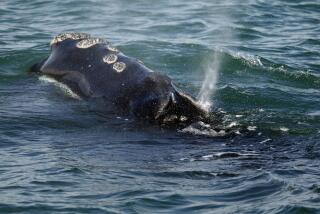Alaskan plain is a killing ground for caribou : Wildlife biologists are at a loss to explain sudden die-off in herd’s population. Thousands are missing and presumed dead.
- Share via
JUNEAU, Alaska — Wildlife experts are trying to unscramble the kind of mystery that unfolds only in Alaska, where herds of great animals can wander through the wilderness for months without ever encountering civilization.
The mystery surfaced this summer when biologists with the Alaska Department of Fish and Game discovered that around 3,000 caribou were missing and presumed dead from the herd that grazes on the flat coastal plains of Bristol Bay several hundred miles west of Anchorage. The herd normally numbers about 15,000, so the missing caribou amounted to a significant percentage.
But more troubling than the decline was the fact that there seemed to be no apparent reason for it.
“It’s really puzzling,” said state wildlife biologist Dick Sellers, who monitors the Alaska Peninsula’s northern herd.
Ken Pitcher, a state wildlife supervisor, said, “We just got smacked between the eyes with it.”
Any decline in caribou population is of concern to wildlife experts because herds have been known to suddenly “crash,” dwindling from tens of thousands to a few hundred in just a few seasons. But usually there are ample warning signs, such as a decline in calving or a particularly harsh winter. That was not the case this time.
The caribou, called reindeer in many other parts of the world, is an important food source for Alaskan natives who live in remote villages scattered across the far north.
Unlike other members of the deer family, both the male and female caribou grow antlers. The bull caribou--which can weigh several hundred pounds--produces a majestic set of horns that sweep several feet over his head and arch forward. The antlers on the female are much smaller, but the female is generally healthier and more robust than the male, according to wildlife experts.
That is one reason Sellers and Pitcher were so surprised by what they found in the field this summer. Radio collars are attached to some members of the herd each year to help monitor the migration of the animals across hundreds of miles of Alaskan wilderness, and 30 females in the herd were so equipped.
But when biologists were surveying the herd this summer, they were astonished to learn that 10 of the 30 collared animals were dead.
Particularly troubling was the fact that 16 of the 30 were collared in April, and they appeared to be in good health at that time, Sellers said.
“Four of the 16 were dead by the end of June,” he said.
Sellers said spring came a little late to that remote area of Alaska, so the willows and dwarf birch and lichen that the caribou feed on were a little late developing, but the 16 caribou captured and collared in April showed no sign of disease or nutritional stress.
“We had a vet with us, and if there was anything wrong with them, he would have been able to pick up on it,” Sellers said.
The animals had been dead several months by the time the biologists found them, so it was impossible in most cases to determine the cause. In two cases, the caribou appeared to have been killed by predators, probably wolves and bears, and a third was apparently killed by a hunter, but there wasn’t a clue as to what killed the other seven.
Sellers and his colleagues plan to monitor the herd closely, because they know how rapidly the numbers can decline. One herd that stays on the southern part of the Alaska Peninsula went into a precipitous decline in the mid-1980s, dropping from 10,000 animals to fewer than 2,000. Sellers believes poor grazing conditions caused that decline, and only recently has the herd begun a slight recovery. The number this year was up to 2,100, still a small herd compared to what it was just a decade ago.
Both herds are relatively small compared to the vast populations that migrate across the northernmost parts of the state. There are believed to be 700,000 caribou in Alaska today, with the largest herd concentrated in the extreme northwest part of Alaska.
They tend to shy away from populated areas, although great herds of thousands of caribou can still be seen by those traveling to some of the most isolated parts of the state. And while the numbers are still high, gone are the days when, old-timers will tell you, “millions” of caribou would wander across a highway, tying up traffic for days.
More to Read
Sign up for Essential California
The most important California stories and recommendations in your inbox every morning.
You may occasionally receive promotional content from the Los Angeles Times.













